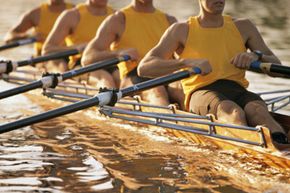Rowing is a sport with a rich history and dedicated following. It boasts a culture that includes sponsorship by some of the most respected universities and nonprofit institutions in the U.S. It has its own distinct language, with unique and sometimes romantic terms to describe the form, function and process of rowing: A race is a "regatta," a boat is a "shell" and the two categories of rowing are "sweep" (one oar held in both hands) and "sculling" (one oar held in each hand). Clearly even the vocabulary of rowing engenders visions of a more leisurely and refined past.
Rowing is a core sport of the modern Olympics and currently comprises one of the largest U.S. delegations to the Olympic Games. Rowing is physically demanding, too, and rowers are widely considered among the most physically fit athletes in competitive sport. For a non-weight bearing activity, rowing still exercises all the main muscle groups, promotes cardiovascular health and improves endurance.
Advertisement
Rowing clubs will typically specialize in either indoor or outdoor rowing. Indoor rowing involves using rowing equipment rather than water boats. Conventional rowing clubs are probably most commonly associated with the outdoor sport of rowing on water. They're often not-for-profit organizations or affiliated with schools or universities. Some rowing clubs offer facilities and services for use by rowers that may include shell rental and storage, dock facilities and training. Many host rowing competitions sanctioned by the U.S. Olympic Committee's recognized governing body for rowing, USRowing.
Rowing clubs and teams can be casual enthusiasts spending time outdoors while getting some exercise, or professional athletes participating in US Rowing national team qualifying events.
On the next page, we'll take a look at a few things to consider when starting a rowing club. From obtaining insurance to charging fees, there's more to rowing than just getting to the dock on time.
Advertisement



